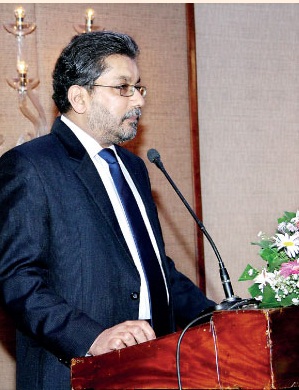
Friday 27th June 2014
A synopsis of the keynote address delivered by Institute of Policy Studies Executive Director Dr. Saman Kelegama at the Annual General Meeting of the Institute of Hospitality – Sri Lanka Chapter, Hotel Ramada on 20 June
In Sri Lanka, one sector that featured prominently in the post-war rapid growth was the tourism sector. The arrival of tourists increased rapidly and passed the elusive one million mark in 2012 and increased further in 2013. Consequently, the tourist earnings also increased and now (2013) the sector occupies the position as the third largest foreign exchange earner to the country ($ 1.7 billion) after overseas remittances ($ 6.4 billion) and textiles and apparel exports ($ 4.5 billion).
A growing sector in an economy always faces challenges and the Sri Lankan tourism sector is no exception. These challenges have been highlighted by various commentators from time to time. An attempt is made here to highlight six challenges confronting the sector and the need to address them by both the tourist industry and the Government.

IPS Executive Director Dr.Saman Kelegamadelivering the key note address
Deepening and broadening the availability of tourism data
To do any comprehensive analysis of the sector there needs to be a solid data base, however, available data have a number of shortcomings. Two cases may be highlighted. First, the tourism arrival figure for 2013 is given as 1.27 million after a correction was made by reconciling online and manual figures.
Irrespective of the accuracy of this figure, what anyone studying the tourist sector would like to know is the actual number of tourists who spend 24 hours or more and spend on a hotel night out of this number? The current figure includes many Sri Lankans with foreign passports, foreigners working in embassies for a short period, NGO workers, donor organisation staff – all of whom come for a limited period less than one year, as well as businessmen/traders who come for a couple of nights that are spent with business partners. If all these are factored in, the actual tourist hotel nights will apply only to about 75% of this figure of arrivals.
“Another issue that arises is which kind of tourists are we targeting – high-end, middle or the lower-end? Some argue that we must target the higher-end and focus on smaller number of tourists who are high spenders and bring more foreign exchange earnings. This is however debatable; Sri Lanka is still considered as a ‘value for-money cheap-end destination’ and this remains its strength. Thus the lower end should not be abandoned, while gradually developing the high-end and the middle level tourism
We need to move fast to make this sector a larger contributor to the economy. The current contribution of tourism to GDP is close to an average of 2% (1.7% in 2012 and 2.5% in 2013).
Some of Sri Lanka’s Asian competitors are at a much higher level of tourism sector contribution to GDP, for example, Malaysia – 12.5%, Vietnam – 7.5% and Singapore – 5%. All these challenges among others need to be addressed on a fast track basis if Sri Lanka is to make the tourism sector an above 5% of GDP contributor to the economy after 2016. This is certainly not an impossible task if a master plan is worked out by the industry and the Government”
Second, the Foreign Guest Nights (FGNs) data from the informal sector is not available. With the popularising of the internet and social media, many young tourists look for cheaper hotels in the informal sector and all indications are that the informal sector will grow as rapidly as the formal sector. Data indicates that there are close to 11,700 rooms in the informal sector compared to 15,000 rooms in the formal sector and that is the only data available on the informal sector. Thus, more aggregate data on the informal sector will be useful for policy formulation and making more meaningful decisions on undertaking investment in the tourism sector.
Accurate information on FGNs is not available for the registered hotels also as some of these hotels do not submit this information on a timely basis. According to the CBSL – AR 2013, the maximum FGNs is in the Southern Coast followed by Colombo city during the post-war period but for the first time, Ancient Cities ranked second in 2013. The Hill Country and the Eastern Coast perform relatively poorly in terms of FGNs. While this is the picture that emerges from the formal sector, the point to consider is whether the picture will change if the informal sector is incorporated. These are the questions that need answers for investment expansion in the tourist industry.
Targeting 2.5 million tourists by 2016
It is contended that the current 26,700 rooms (15,000 + 11,700) should be increased to about 50,000 rooms by 2016 if we are to accommodate the 2.5 million tourists that are targeted for 2016.There are reasons to believe that the estimate of 50,000 rooms was to accommodate the peak season tourists during November to January.
It was reported in an article titled ‘Hotel construction explodes’ (The Sunday Times, 8 June 2014) that during 2014-2016, 5,306 rooms will come into operation with 75 hotels under construction. If it is assumed that another 4,000 rooms will come into operation in the informal hotel sector during the same period, there will be 9,306 rooms and when this is added to the 26,700 existing rooms, it will come to about 36,000 rooms, still short of the target of 50,000 rooms.
In the Sunday Times report, Shangri-La, Hyatt, ITC and the mixed hotels – Krrish, JKH Waterfront, Queensbury, Crown Plaza of Packer, etc. – have not been mentioned. It has also not discussed the challenge to hotel rooms by the glut of condominium apartments coming up, especially in the city of Colombo. There are number of condominium apartments that are now rented out to tourists. Thus, a more careful estimation needs to be done to judge the situation whether there is an under-supply of hotel rooms.
Clearly, the rooms coming up will be more than 36,000 if the left out component is added and will be most probably above 40,000. There are reasons to believe that this number will be adequate. First, the 2.5 million target may not be achieved in 2016. Second, even if the target is achieved, only about 75% will be actual FGN-related tourists, i.e., about 1.9 million. Further, there will be seasonality factor – periods where tourist flows are less. When all these factors are taken into consideration, the room number seems to be reasonably correct to accommodate the 2016 inflows.
In this respect, one may also recall what happened in the past. Before the 2011 World Cup Cricket, it was stated that there will be a large influx of tourists that the hotels will not be able to accommodate.
Thus, it was argued by some commentators that we may have to hire cruise liners to be parked in the Colombo Harbour to accommodate the excess tourists! Then last year, it was stated that Colombo will be flooded with foreigners when CHOGM starts and a minimum 4,000 rooms will be occupied. Both these proved to be highly exaggerated. No cruise ships were required for the World Cup and only about 2,000 rooms were occupied for CHOGM and the Colombo city hotel occupancy rate during CHOGM was 30% to 40%. Hence, over-exaggeration is an aspect that we have to discount in the tourist industry.
Earlier, the need was emphasised for a good data base on the tourist industry to make informed and sensible decisions. When data is weak, market gossip and herd instinct tend to take over and there can be an over-supply of rooms and cut-throat competition to attract tourists, while the government agencies will give quick approvals to hotel projects without giving much consideration to the qualitative aspects.
Minimum price for Colombo hotels
This was imposed after the war ended to control price undercutting in city hotels and truly reflect the standard of the hotels in the absence of the war-risk factor. As a result, the Colombo city hotel rates have increased by 40%-50%.
Although an initial price correction was required, whether the price of $ 180 per night for five star hotels unmatched by the services offered, was an over-pricing is questionable. It is reported that the Colombo city hotels had seen a decline in occupancy because tourists feel that they do not get value for money with such pricing. That there is a problem in price fixing is not only felt in Sri Lanka but also outside the country.
Recently, the Director of the Russia Centre of the Russian Embassy in Colombo had stated that more Russian tourists will come to Sri Lanka if the price quality ratio is realistic (The Island, 9 June 2014). For 2014, the Sri Lanka Tourism Development Authority has projected 90,000 Russian tourist-inflows but the Director of the Russian Centre feels that the number could be much more if the price-quality ratio is addressed.
Unfortunately, minimum prices came at a time when the global economy was on a downturn, and disposable incomes of tourists were falling.
The minimum price is good as an initial correction but also has its fall outs just like the market price which encourages undercutting. The stakeholders of the tourism industry will have to work out a compromise formula until a market regulator is established for the sector which is the case in all matured market economies in the world.
“To match the slogan ‘Wonder of Asia,’ what are the wonders that Sri Lanka possesses? Two items that are noteworthy are Sigiriya and the gathering of elephants in Minneriya. Other than these two, one cannot think of any other wonder in Sri Lanka. Therefore, it is questionable whether the branding of the destination is correctly placed
Sri Lanka lacks a cohesive marketing strategy and campaign which should be a mutually-agreed private-public partnership. There are various promotional exhibitions that have taken place in foreign capitals in the past but they are not based on a master plan to promote the market destination. There is much more work that needs to be done in this area”
Once a regulator is in place, it will be more prudent to allow the demand and supply forces or the market to take over to discover the equilibrium price. If not, with the occupancy falling, the desired capacity fulfilment will not take place in these hotels and it will prove difficult to achieve the set tourist target.
Human resource constraint
The number of total hotel rooms will increase to a level above 40,000 from the current 26,700 by 2016 as argued earlier. This will be a result of the number of hotels increasing by 75 in the formal sector and an unknown number in the informal sector. In this context, the question arises as to whether the human resources are adequate to meet this increase in hotels.
If one goes to any hotel in Maldives, UAE, Qatar or Oman one finds Sri Lankan workers – managers, cooks, waiters, gardeners, room boys, hotel car drivers, etc., clearly, revealing that some of the skilled and semi-skilled workers in the hotel industry have migrated overseas.
Meanwhile, the Sri Lanka Institute of Tourism and Hotel Management is bringing out close to 4,000 trained personnel per annum. Some of the Universities like Sabaragamuwa and Uva-Wellassa also produce 50 to 150 tourism trained graduates per annum. Apart from these, the existing private colleges in tourism also bring out some trained personnel although one cannot be sure about the quality of this training.
Nevertheless, all these trained outputs will not be adequate to meet the expansion and growth of hotels. Moreover, the quality of output, especially the proficiency in English and some other key languages, does not appear to receive much attention in the current training programs. Thus, the human resource constraint remains a major challenge the industry will face in the coming years which both the industry and the government have to immediately address.
Brand destination
To achieve the 2016 target it is necessary for Sri Lanka to have an effective tourism promotional strategy. In
this context, two issues can be raised. First, does Sri Lanka have an effective brand destination? Second, is there a general marketing strategy for tourism? For brand destination, while Sri Lanka some years back had a slogan ‘Paradise Island,’ by the late 1990s, it changed to ‘Land Like No Other,’ then it changed to the current one: ‘Wonder of Asia’. Before the latest brand name came into being, the tourist industry came out with ‘Small Miracle,’ which did not receive a favourable response from the Government and was consequently rejected.
To match the slogan ‘Wonder of Asia,’ what are the wonders that Sri Lanka possesses? Two items that are noteworthy are Sigiriya and the gathering of elephants in Minneriya. Other than these two, one cannot think of any other wonder in Sri Lanka. Therefore, it is questionable whether the branding of the destination is correctly placed.
If one takes a country like Singapore, at one time it was marketed as ‘Uniquely Singapore’ and when the country discovered diminishing returns from that slogan it was changed to ‘Yours Singapore’ to underpin its strengths as a destination. The re-branding was accompanied by a change in the offerings to tourists with the introduction of Formula One Racing, Casinos, and other night entertainments. The re-branding focused on the experience of a tourist that could be personalised – sound, tastes, sights, user-centricity, etc.
Branding a destination has to be a carefully-thought-out exercise based on the competitive strength and strategic position vis-à-vis the competitors. It is on this basis that countries have branded their tourism. For example, Greece – ‘A Masterpiece You Can Afford’; Canada – ‘Keep Exploring’; Malaysia – ‘Truly Asia’; Bulgaria – ‘A Discovery to Share’; India – ‘Incredible India’; Vietnam – ‘A Different Orient’; Maldives – ‘Always Natural,’ and so on.
Marketing strategy
Sri Lanka lacks a cohesive marketing strategy and campaign which should be a mutually-agreed private-public partnership. There are various promotional exhibitions that have taken place in foreign capitals in the past but they are not based on a master plan to promote the market destination. There is much more work that needs to be done in this area.
Even target group marketing is lacking. For example, is Sri Lanka making any attempt to attract some of the Italian and Chinese young couples that travel to Maldives for their honeymoon? East China Airlines that flies from Kunming in China to Maldives via Colombo has only 3% to 5% of passengers who get down in Colombo and this is the case in the return flight from Maldives to Kunming also. Italians who travel for sun and sand to Maldives are not fully aware of the different tourism products that Sri Lanka offers to complement their Maldivian experience. In sum, Sri Lanka has failed to market the country as one that offers a different product from that of Maldives to both Chinese and Italians who travel to Maldives in large numbers.
In this connection, another issue that arises is which kind of tourists are we targeting – high-end, middle or the lower-end? Some argue that we must target the higher-end and focus on smaller number of tourists who are high spenders and bring more foreign exchange earnings. This is however debatable; Sri Lanka is still considered as a ‘value for-money cheap-end destination’ and this remains its strength. Thus the lower end should not be abandoned, while gradually developing the high-end and the middle level tourism.
Here the example of Bangladesh in ready-made garment exports may be highlighted. By continuously focusing on the low end, Bangladesh has developed its ready-made garment industry to $ 20 billion export earner by increasing its volumes when Sri Lanka shifted away from the lower end and focused on more niche products with high value. Still, the value and volumes bring in $ 4 b export earnings to Sri Lanka, much less than Bangladesh – a country which was behind Sri Lanka in ready-made garment exports in 1990.
Thus, Sri Lanka should focus on its strength at the low end of the market but at the same time, develop the structure to attract middle level and high-spending tourists and also MICE tourists which brings higher earning than leisure tourists.
Concluding remarks
It is apparent therefore that we need to move fast to make this sector a larger contributor to the economy. The current contribution of tourism to GDP is close to an average of 2% (1.7% in 2012 and 2.5% in 2013). Some of Sri Lanka’s Asian competitors are at a much higher level of tourism sector contribution to GDP, for example, Malaysia – 12.5%, Vietnam – 7.5% and Singapore – 5%. All these challenges among others need to be addressed on a fast track basis if Sri Lanka is to make the tourism sector an above 5% of GDP contributor to the economy after 2016. This is certainly not an impossible task if a master plan is worked out by the industry and the Government.
http://www.ft.lk/2014/06/27/key-challenges-facing-the-tourism-sector-in-sri-lanka/




